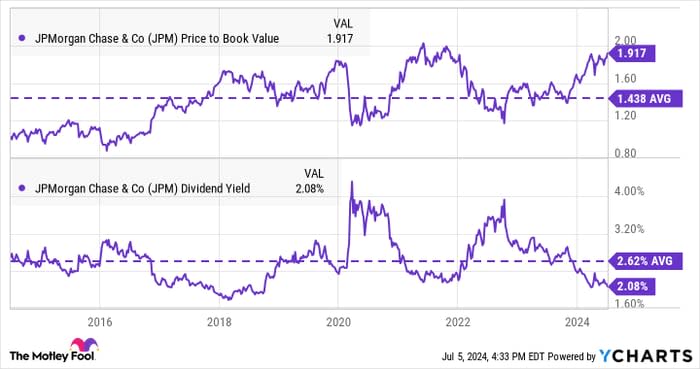Should You Buy JPMorgan Chase Stock Before July 12?
Shares of JPMorgan Chase (NYSE: JPM) have created wealth for investors, delivering a 20% return this year and even outperforming the S&P 500 index thus far in 2024. There's a lot to like about the megabank, which has benefited from resilient economic conditions and climbing financial asset prices.
That backdrop will be in focus as the company reports its second-quarter results on July 12 (for the period ended June 30). With the stock trading near a record high, can the rally keep going, and should you buy shares in JPMorgan Chase before its Q2 earnings report?
Let's explore the themes to consider.
The attraction of a fortress balance sheet
The attraction of JPMorgan Chase as an investment opportunity starts with its position as the largest U.S. banking institution, diversified globally across financial services.
The importance of its scale has been highlighted since the 2023 industry turmoil when a handful of smaller banks collapsed. At a time when regional institutions faced a loss of investor confidence and capital flight, JPMorgan has managed to grow its asset and deposit base.
The bank's "fortress balance sheet" has been reaffirmed by recently clearing the Federal Reserve's 2024 Dodd-Frank Act Stress Test. JPMorgan Chase reported a standardized Common Equity Tier 1 capital ratio of 15%, well above the 11.9% regulatory requirement. The stress test results showed that JPMorgan is well prepared to withstand a hypothetical economic shock, a confirmation of its solid fundamentals.
The results opened the door for the bank to move forward with its latest dividend hike, increasing the quarterly payout by 9% to $1.25 per share while also issuing a new $30 billion share repurchase authorization. Overall, JPMorgan Chase is off to a strong start in 2024 and maintains a positive long-term outlook.

Image source: Getty Images.
What to expect from JPMorgan Chase's Q2 earnings
For the second quarter, JPMorgan is seen capturing a boost from not only the impact of elevated interest rates on net interest income but also an ongoing rebound in areas like investment banking activity and a valuation gain in wealth management assets.
Compared to fears of a looming recession in recent years, macro data points like steady U.S. job gains and low levels of corporate defaults are good news. A question this quarter will be the size of adjustments to the bank's provision for credit losses, last reported at $1.9 billion in Q1.
A materially larger figure in Q2 would imply concern for underlying credit conditions and the health of borrowers in areas such as consumer lending, mortgages, credit cards, and corporate banking. On the other hand, a move by JPMorgan to release some of its reserves with a lower provision for credit losses would signal confidence that credit conditions are improving.
This side of credit costs will be the key factor in the net income result this quarter. The market will also be closely following the tone set by Chairman and CEO Jamie Dimon as a bellwether for the broader banking industry.
Is JPMorgan stock a buy?
Recognizing JPMorgan Chase's high-quality leadership profile and bullish long-term outlook, I believe there is some room for caution heading into this report. A hold rating for the stock is likely the most prudent move.
First, with shares trading at a record high, the interpretation is that there is now a high bar of expectations. Even with a strong Q2 report, there is the potential for near-term volatility as the market incorporates the update.
Second, a premium valuation for shares of JPMorgan could warrant a pause. The stock is trading at 1.9 times its book value, a level that is now well above the decade average for the metric closer to 1.4. Similarly, the stock's dividend yield of 2.1% has narrowed toward its lowest level in the past decade.
While these dynamics don't necessarily mean shares need to sell off, a repeat of the stock's large rally from the first half of the year would likely be more difficult from here.
JPM Price to Book Value data by YCharts
Ultimately, the many moving parts in earnings reports add to risks. Investors interested in adding JPMorgan Chase to their portfolios may be better off waiting until after the Q2 results for more clarity and a potentially more attractive entry point.
Should you invest $1,000 in JPMorgan Chase right now?
Before you buy stock in JPMorgan Chase, consider this:
The Motley Fool Stock Advisor analyst team just identified what they believe are the 10 best stocks for investors to buy now… and JPMorgan Chase wasn’t one of them. The 10 stocks that made the cut could produce monster returns in the coming years.
Consider when Nvidia made this list on April 15, 2005... if you invested $1,000 at the time of our recommendation, you’d have $785,556!*
Stock Advisor provides investors with an easy-to-follow blueprint for success, including guidance on building a portfolio, regular updates from analysts, and two new stock picks each month. The Stock Advisor service has more than quadrupled the return of S&P 500 since 2002*.
*Stock Advisor returns as of July 8, 2024
JPMorgan Chase is an advertising partner of The Ascent, a Motley Fool company. Dan Victor has no position in any of the stocks mentioned. The Motley Fool has positions in and recommends JPMorgan Chase. The Motley Fool has a disclosure policy.

